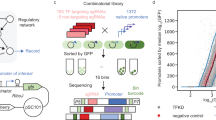Abstract
RNA-seq enables the analysis of gene expression profiles across different conditions and organisms. Gene expression burden slows down growth, which results in poor predictability of gene constructs and product yields. Here, we describe how we applied RNA-seq to study the transcriptional profiles of Escherichia coli when burden is elicited during heterologous gene expression. We then present how we selected early responsive promoters from our RNA-seq results to design sensors for gene expression burden. Finally, we describe how we used one of these sensors to develop a burden-driven feedback regulator to improve cellular fitness in engineered E. coli.
Access this chapter
Tax calculation will be finalised at checkout
Purchases are for personal use only
Similar content being viewed by others
References
Ceroni F, Algar R, Stan G-B, Ellis T (2015) Quantifying cellular capacity identifies gene expression designs with reduced burden. Nat Methods 12:415–418. https://doi.org/10.1038/nmeth.3339
Borkowski O, Ceroni F, Stan GB, Ellis T (2016) Overloaded and stressed: whole-cell considerations for bacterial synthetic biology. Curr Opin Microbiol 33:123–130. https://doi.org/10.1016/j.mib.2016.07.009
Ellis T (2018) Predicting how evolution will beat us. Microb Biotechnol 12(1):41–43. https://doi.org/10.1111/1751-7915.13327
Martin VJJ, Pitera DJ, Withers ST et al (2003) Engineering a mevalonate pathway in Escherichia coli for production of terpenoids. Nat Biotechnol 21:796–802. https://doi.org/10.1038/nbt833
Gyorgy A, Jiménez JI, Yazbek J et al (2015) Isocost lines describe the cellular economy of genetic circuits. Biophys J 109:639–646. https://doi.org/10.1016/j.bpj.2015.06.034
Shachrai I, Zaslaver A, Alon U, Dekel E (2010) Cost of unneeded proteins in E. coli is reduced after several generations in exponential growth. Mol Cell 38:758–767. https://doi.org/10.1016/j.molcel.2010.04.015
Gertz J, Varley KE, Davis NS et al (2012) Transposase mediated construction of RNA-seq libraries. Genome Res 22:134–141. https://doi.org/10.1101/gr.127373.111.134
Gorochowski TE, Espah Borujeni A, Park Y et al (2017) Genetic circuit characterization and debugging using RNA-seq. Mol Syst Biol 13:952. https://doi.org/10.15252/msb.20167461
Der BS, Glassey E, Bartley BA et al (2017) DNAplotlib: programmable visualization of genetic designs and associated data. ACS Synth Biol 6:1115–1119. https://doi.org/10.1021/acssynbio.6b00252
Myers CJ, Beal J, Gorochowski TE et al (2017) A standard-enabled workflow for synthetic biology. Biochem Soc Trans 45:793–803. https://doi.org/10.1042/BST20160347
Ceroni F, Boo A, Furini S et al (2018) Burden-driven feedback control of gene expression. Nat Methods 15:387–393. https://doi.org/10.1038/nmeth.4635
Love MI, Huber W, Anders S (2014) Moderated estimation of fold change and dispersion for RNA-seq data with DESeq2. Genome Biol 15:1–21. https://doi.org/10.1186/s13059-014-0550-8
Keseler IM, Mackie A, Santos-Zavaleta A et al (2017) The EcoCyc database: reflecting new knowledge about Escherichia coli K-12. Nucleic Acids Res 45:D543–D550. https://doi.org/10.1093/nar/gkw1003
Farasat I, Salis HM (2016) A biophysical model of CRISPR/Cas9 activity for rational design of genome editing and gene regulation. PLoS Comput Biol 12:1–33. https://doi.org/10.1371/journal.pcbi.1004724
Petrova OE, Garcia-Alcalde F, Zampaloni C, Sauer K (2017) Comparative evaluation of rRNA depletion procedures for the improved analysis of bacterial biofilm and mixed pathogen culture transcriptomes. Sci Rep 7:1–15. https://doi.org/10.1038/srep41114
Haldimann A, Wanner BL (2001) Conditional-replication, integration, excision, and retrieval plasmid-host systems for gene structure-function studies of bacteria. J Bacteriol 183:6384–6393. https://doi.org/10.1128/JB.183.21.6384
Algar RJR (2013) Understanding, characterising and modelling the interactions between synthetic genetic circuits and their host chassis Rhys James Richmond Algar, MA (Oxon), MRes Submission for the degree of PhD. Imperial College London
Author information
Authors and Affiliations
Corresponding author
Editor information
Editors and Affiliations
Rights and permissions
Copyright information
© 2021 Springer Science+Business Media, LLC, part of Springer Nature
About this protocol
Cite this protocol
Boo, A., Ceroni, F. (2021). Engineering Sensors for Gene Expression Burden. In: Menolascina, F. (eds) Synthetic Gene Circuits . Methods in Molecular Biology, vol 2229. Humana, New York, NY. https://doi.org/10.1007/978-1-0716-1032-9_15
Download citation
DOI: https://doi.org/10.1007/978-1-0716-1032-9_15
Published:
Publisher Name: Humana, New York, NY
Print ISBN: 978-1-0716-1031-2
Online ISBN: 978-1-0716-1032-9
eBook Packages: Springer Protocols




